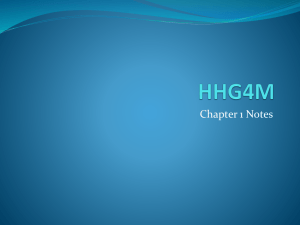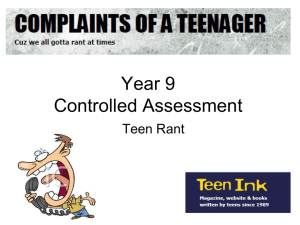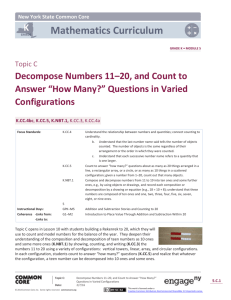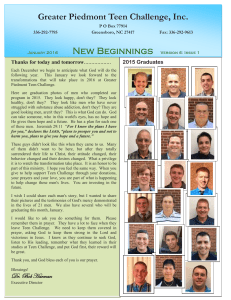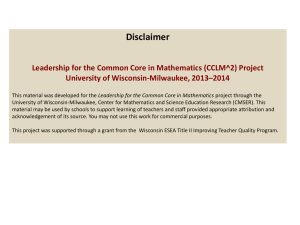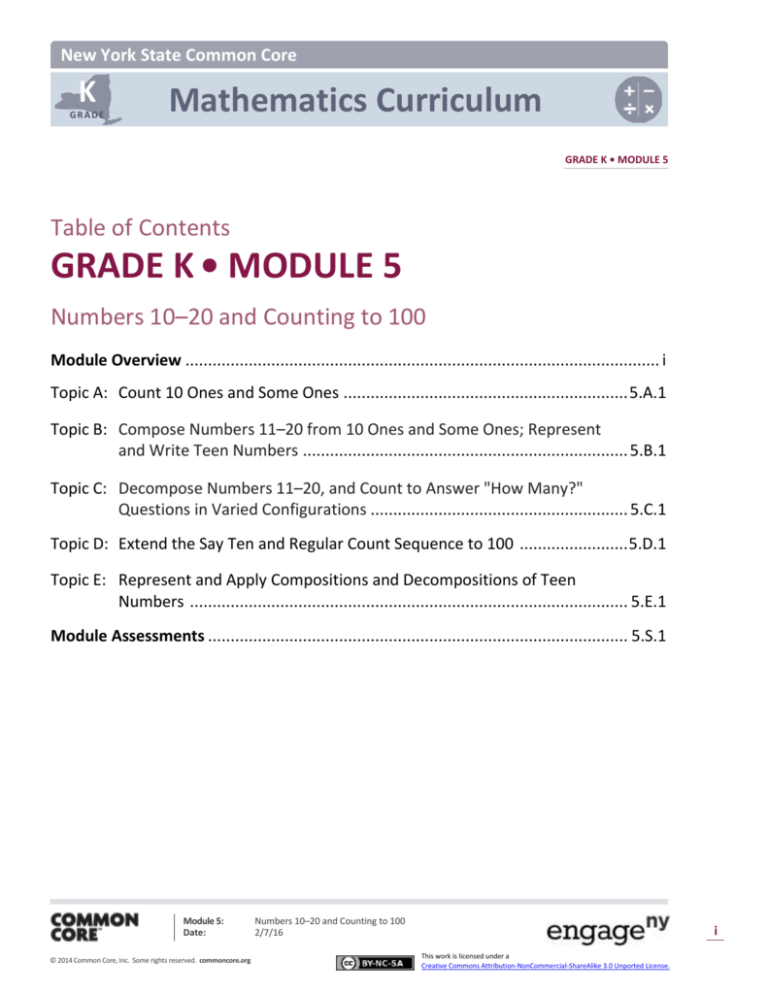
New York State Common Core
K
GRADE
Mathematics Curriculum
GRADE K • MODULE 5
Table of Contents
GRADE K • MODULE 5
Numbers 10–20 and Counting to 100
Module Overview ......................................................................................................... i
Topic A: Count 10 Ones and Some Ones ............................................................... 5.A.1
Topic B: Compose Numbers 11–20 from 10 Ones and Some Ones; Represent
and Write Teen Numbers ........................................................................ 5.B.1
Topic C: Decompose Numbers 11–20, and Count to Answer "How Many?"
Questions in Varied Configurations ......................................................... 5.C.1
Topic D: Extend the Say Ten and Regular Count Sequence to 100 ........................ 5.D.1
Topic E: Represent and Apply Compositions and Decompositions of Teen
Numbers ................................................................................................. 5.E.1
Module Assessments ............................................................................................. 5.S.1
Module 5:
Date:
© 2014 Common Core, Inc. Some rights reserved. commoncore.org
Numbers 10–20 and Counting to 100
2/7/16
i
This work is licensed under a
Creative Commons Attribution-NonCommercial-ShareAlike 3.0 Unported License.
NYS COMMON CORE MATHEMATICS CURRICULUM
Module Overview K•5
Grade K • Module 5
Numbers 10–20 and Counting to 100
OVERVIEW
Students have worked intensively within 10 and have often counted to 30 using the Rekenrek during Fluency
Practice. This sets the stage for Module 5, where students clarify the meaning of the 10 ones and some ones
within a teen number and extend that understanding to count to 100. In Topic A, students start at the
concrete level, counting 10 straws.
T:
S:
T:
S:
Count straws with me into piles of ten.
1, 2, 3, 4, 5, 6, 7, 8, 9, 10. 1, 2, 3, 4, 5, 6, 7, 8, 9, 10. 1, 2, 3, … 8, 9, 10. 1, 2, 3, … 8, 9, 10.
Let’s count the piles!
1 pile, 2 piles, 3 piles, 4 piles.
Thus, Kindergarten students learn to comfortably talk about 10 ones, setting the foundation for the critical
Grade 1 step of understanding 1 ten. They next separate 10 objects from within concrete and pictorial counts
up to 20, analyzing the total as 10 ones and no ones or 10 ones and some ones (K.CC.1, K.NBT.1). They see
two distinct sets which are then counted the Say Ten Way: ten one, ten two, ten three, ten four, ten five, ten
six, ten seven, ten eight, ten nine, 2 tens. The students hear the separation of the 10 ones and some ones as
they count, solidifying their understanding as they also return to regular counting: eleven, twelve,
thirteen…etc. (K.CC.5)
In Topic B, the two distinct sets of ones are composed, or brought together, through the use of the Hide Zero
cards (pictured below) and number bonds. Students represent the whole number numerically while
continuing to separate the count of 10 ones from the count of the remaining ones with drawings and
materials (K.NBT.1). Emerging from Topic B, students should be able to model and write a teen number
without forgetting that the 1 in 13 represents 10 ones (K.CC.3).
Module 5:
Date:
© 2014 Common Core, Inc. Some rights reserved. commoncore.org
Numbers 10–20 and Counting to 100
2/7/16
ii
This work is licensed under a
Creative Commons Attribution-NonCommercial-ShareAlike 3.0 Unported License.
Module Overview K•5
NYS COMMON CORE MATHEMATICS CURRICULUM
Topic C opens with the students making a simple Rekenrek to 20 (pictured below) and modeling numbers
thereon. The tens can be seen both as two lines with a color change at the five or two parallel unicolor fives.
In Topic C, the focus is now on the decomposition of the total teen quantity so that one part is ten ones. This
is what makes Topic C a step forward from Topics A and B. Previously, the ten and ones were always
separated when modeled pictorially or with materials. Now, the entire teen number is a whole quantity
represented both concretely and pictorially in different configurations: towers or linear configurations, arrays
(including the 10-frame or 5-groups), and circles. The students decompose the total into 10 ones and some
ones. Through their experiences with the different configurations, students have practice both separating 10
ones within teen numbers and counting or conservation as they count quantities arranged in different ways
and, as always, use math talk to share their observations (K.CC.5). They also come to know each successive
teen number as one larger than the previous number (K.CC.4a).
Towers
Arrays
Circles
I have 10 ones and 2 ones.
10 and 2 is ___.
12 = 10 + ___.
In Topic D, students extend their understanding of counting teen numbers to numbers from 21 to 100. They
first count by tens both the Say Ten Way—1 ten, 2 tens, 3 tens, 4 tens, etc.—and the regular way: twenty,
thirty, forty, etc. They then count by ones to 100, first within a decade and finally across the decade (K.CC.1,
K.CC.2). Topic D involves the Grade 1 standard 1.NBT.1 because students also write their numbers from 21 to
100.
The writing of larger numbers has been included because of the range of activities they make possible. The
writing of these numbers is not assessed or emphasized, however. Topic D closes with an optional
exploration of numbers on the Rekenrek, bringing together counting with decomposition and finding
embedded numbers within larger numbers. This lesson is optional because it does not directly address a
particular Kindergarten standard.
In Topic E, students apply their skill with the decomposition and composition of teen numbers. In Lesson 20,
they represent both compositions and decompositions as addition statements (K.NBT.1). In Lesson 21, they
Module 5:
Date:
© 2014 Common Core, Inc. Some rights reserved. commoncore.org
Numbers 10–20 and Counting to 100
2/7/16
iii
This work is licensed under a
Creative Commons Attribution-NonCommercial-ShareAlike 3.0 Unported License.
NYS COMMON CORE MATHEMATICS CURRICULUM
Module Overview K•5
model teen quantities with materials in a number bond and hide one part. The hidden part is represented as
an addition sentence with a hidden part, e.g., 10 + ___ = 13 or 13 = ___ + 3. The missing addend aligns
Lesson 21 to the Grade 1 standard 1.OA.8. In Lesson 22, students apply their skill with decomposition into 10
ones and some ones to compare the some ones of two numbers and thus to compare the teen numbers.
They stand on the structure of the 10 ones and use what they know of numbers 1–9 (MP.7). Comparison of
numbers 1–9 is a Kindergarten standard (K.CC.6, K.CC.7).
In Lesson 23, students reason about situations to determine whether they are decomposing a teen number
(as 10 ones and some ones) or composing 10 ones and some ones to find a teen number. They analyze their
number sentences that represent each situation to determine if they started with the total or the parts and if
they composed or decomposed, for example, 13 = 10 + 3 or 10 + 3 = 13 (K.NBT.1). Throughout the lesson,
students draw the number of objects presented in the situation (K.CC.5).
The module closes with a culminating task, wherein students integrate all the methods they have used up
until now to show decomposition. For example, they are instructed, “Open your mystery bag. Show the
number of objects in your bag in different ways using the materials you choose” (MP.5). This experience also
serves as a part of the End-of-Module Assessment, allowing the student to demonstrate skill and
understanding using all he has learned throughout the module.
Module 5:
Date:
© 2014 Common Core, Inc. Some rights reserved. commoncore.org
Numbers 10–20 and Counting to 100
2/7/16
iv
This work is licensed under a
Creative Commons Attribution-NonCommercial-ShareAlike 3.0 Unported License.
Module Overview K•5
NYS COMMON CORE MATHEMATICS CURRICULUM
Focus Grade Level Standards
Know number names and the count sequence.
K.CC.1
Count to 100 by ones and by tens.
K.CC.2
Count forward beginning from a given number within the known sequence (instead of having
to begin at 1).
K.CC.3
Write numbers from 0 to 20. Represent a number of objects with a written numeral 0–20
(with 0 representing a count of no objects).
Count to tell the number of objects.1
K.CC.4
Understand the relationship between numbers and quantities; connect counting to
cardinality.
b. Understand that the last number name said tells the number of objects counted. The
number of objects is the same regardless of their arrangement or the order in which they
were counted.
c. Understand that each successive number name refers to a quantity that is one larger.
K.CC.5
Count to answer “how many?” questions about as many as 20 things arranged in a line, a
rectangular array, or a circle, or as many as 10 things in a scattered configuration; given a
number from 1–20, count out that many objects.
Work with numbers 11–19 to gain foundations for place value.
K.NBT.1
Compose and decompose numbers from 11 to 19 into ten ones and some further ones, e.g.,
by using objects or drawings, and record each composition or decomposition by a drawing or
equation (e.g., 18 = 10 + 8); understand that these numbers are composed of ten ones and
one, two, three, four, five, six, seven, eight, or nine ones.
Focus Standards for Mathematical Practice
MP.2
Reason abstractly and quantitatively. Students represent teen numerals with concrete
objects separated as 10 ones and some ones.
MP.3
Construct viable arguments and critique the reasoning of others. Students explain their
thinking about teen numbers as 10 ones and some ones and how to represent those numbers
as addition sentences.
MP.4
Model with mathematics. Students model teen quantities with number bonds, place value
cards, and teen numbers.
MP.7
Look for and make use of structure. Students use the structure of 10 ones to reason about
teen numbers. They compare teen numbers using the structure of the 10 ones to compare the
some ones.
1
K.CC.4a is addressed in Module 1; K.CC.4d is addressed in Module 6.
Module 5:
Date:
© 2014 Common Core, Inc. Some rights reserved. commoncore.org
Numbers 10–20 and Counting to 100
2/7/16
v
This work is licensed under a
Creative Commons Attribution-NonCommercial-ShareAlike 3.0 Unported License.
Module Overview K•5
NYS COMMON CORE MATHEMATICS CURRICULUM
Overview of Module Topics and Lesson Objectives
Standards
Topics and Objectives
K.CC.1
K.NBT.1
K.CC.2
K.CC.4a
K.CC.4b
K.CC.4c
K.CC.5
A
K.CC.3
K.NBT.1
K.CC.1
K.CC.2
K.CC.4a
K.CC.4b
K.CC.4c
K.CC.5
K.CC.4b
K.CC.4c
K.CC.5
K.NBT.1
K.CC.3
K.CC.4a
K.CC.1
K.CC.2
K.CC.3
K.CC.4c
K.CC.5
B
C
D
Days
5
Count 10 Ones and Some Ones
Lesson 1:
Count straws into piles of ten; count the piles as 10 ones.
Lesson 2:
Count 10 objects within counts of 10 to 20 objects, and describe as 10
ones and ___ ones.
Lesson 3:
Count and circle 10 objects within images of 10 to 20 objects, and
describe as 10 ones and ___ ones.
Lesson 4:
Count straws the Say Ten Way to 19; make a pile for each ten.
Lesson 5:
Count straws the Say Ten Way to 20; make a pile for each ten.
Compose Numbers 11–20 from 10 Ones and Some Ones; Represent and Write Teen
Numbers
Lesson 6:
Model with objects and represent numbers 10 to 20 with place value or
Hide Zero cards.
Lesson 7:
Model and write numbers 10 to 20 as number bonds.
Lesson 8:
Model teen numbers with materials from abstract to concrete.
Lesson 9:
Draw teen numbers from abstract to pictorial.
Decompose Numbers 11–20, and Count to Answer “How Many?” Questions in Varied
Configurations
Lesson 10:
Build a Rekenrek to 20.
Lesson 11:
Show, count, and write numbers 11 to 20 in tower configurations
increasing by 1—a pattern of 1 larger.
Lesson 12:
Represent numbers 20 to 11 in tower configurations decreasing by 1—a
pattern of 1 smaller.
Lesson 13:
Show, count, and write to answer how many questions in linear and
array configurations.
Lesson 14:
Show, count, and write to answer how many questions with up to 20
objects in circular configurations.
4
5
Mid-Module Assessment: Topics A–C (Interview style assessment)
3
Extend the Say Ten and Regular Count Sequence to 100
5
Lesson 15:
Count up and down by tens to 100 with Say Ten and regular counting.
Lesson 16:
Count within tens by ones.
Module 5:
Date:
© 2014 Common Core, Inc. Some rights reserved. commoncore.org
Numbers 10–20 and Counting to 100
2/7/16
vi
This work is licensed under a
Creative Commons Attribution-NonCommercial-ShareAlike 3.0 Unported License.
NYS COMMON CORE MATHEMATICS CURRICULUM
Standards
Topics and Objectives
K.NBT.1
1.NBT.12
K.CC.5
K.NBT.1
K.CC.1
K.CC.2
K.CC.3
K.CC.4c
K.CC.6
1.OA.83
1.NBT.34
Module Overview K•5
E
Days
Lesson 17:
Count across tens when counting by ones through 40.
Lesson 18:
Count across tens by ones to 100 with and without objects.
Lesson 19:
Explore numbers on the Rekenrek. (Optional.)
Represent and Apply Compositions and Decompositions of Teen Numbers
Lesson 20:
Represent teen number compositions and decompositions as addition
sentences.
Lesson 21:
Represent teen number decompositions as 10 ones and some ones, and
find a hidden part.
Lesson 22:
Decompose teen numbers as 10 ones and some ones; compare some
ones to compare the teen numbers.
Lesson 23:
Reason about and represent situations, decomposing teen numbers into
10 ones and some ones and composing 10 ones and some ones into a
teen number.
Lesson 24:
Culminating Task—Represent teen number decompositions in various
ways.
End-of-Module Assessment: Topics D–E (Interview style assessment)
5
3
30
Total Number of Instructional Days
2
Students write numbers 21–100, aligned to Grade 1 standard 1.NBT.1.
While using concrete materials, a hidden part is related to 10 + ___. Missing addends are aligned to 1.OA.8.
4
Kindergarten standards K.CC.6 and K.CC.7 compare numbers to 10. Grade 1’s standard 1.NBT.3 compares numbers
greater than 10.
3
Module 5:
Date:
© 2014 Common Core, Inc. Some rights reserved. commoncore.org
Numbers 10–20 and Counting to 100
2/7/16
vii
This work is licensed under a
Creative Commons Attribution-NonCommercial-ShareAlike 3.0 Unported License.
NYS COMMON CORE MATHEMATICS CURRICULUM
Module Overview K•5
Terminology
New or Recently Introduced Terms
10 and __
10 ones and some ones
10 plus
Hide Zero cards (called Place Value cards in later grades, pictured
to the right)
Regular counting by ones from 11 to 20 (e.g., eleven, twelve, thirteen, etc.)
Regular counting by tens to 100 (e.g., ten, twenty, thirty, forty, fifty, sixty, seventy, eighty, ninety,
one hundred)
Say Ten counting by tens to 100 (e.g., 1 ten, 2 tens, 3 tens, 4 tens, 5 tens, 6 tens, 7 tens, 8 tens,
9 tens, 10 tens)
Teen numbers
Familiar Terms and Symbols5
10-frame
5-group
Circle 10 ones
Circular count
Count 10 ones
Dot path, empty path, number path
Linear count
Number bond
Number tower
Part, whole, total
Say Ten counting (e.g., 11–20 is spoken as “ten one, ten two, ten three, ten four, ten five, ten six,
ten seven, ten eight, ten nine, two tens”)
Scatter count
5
These are terms and symbols students have used or seen previously.
Module 5:
Date:
© 2014 Common Core, Inc. Some rights reserved. commoncore.org
Numbers 10–20 and Counting to 100
2/7/16
viii
This work is licensed under a
Creative Commons Attribution-NonCommercial-ShareAlike 3.0 Unported License.
NYS COMMON CORE MATHEMATICS CURRICULUM
Module Overview K•5
Suggested Tools and Representations
50 sticks or straws for each group of 2 students
Student-made Rekenrek (pictured to the right):
10 red and 10 white pony beads, 1 cardboard strip, 2
elastics
1 egg carton per pair of students with 2 slots cut off to
make a carton with 10 slots
Hide Zero cards (called Place Value cards in later
grades)
Objects to put in the egg carton such as mandarin
oranges, plastic eggs, or beans
Single and double ten-frames
Linking cubes: ideally 10 of two different colors per
student
Number bond template
Scaffolds6
The scaffolds integrated into A Story of Units give alternatives for how students access information as well as
express and demonstrate their learning. Strategically placed margin notes are provided within each lesson
elaborating on the use of specific scaffolds at applicable times. They address many needs presented by
English language learners, students with disabilities, students performing above grade level, and students
performing below grade level. Many of the suggestions are organized by Universal Design for Learning (UDL)
principles and are applicable to more than one population. To read more about the approach to
differentiated instruction in A Story of Units, please refer to “How to Implement A Story of Units.”
6
Students with disabilities may require Braille, large print, audio, or special digital files. Please visit the website
www.p12.nysed.gov/specialed/aim for specific information on how to obtain student materials that satisfy the National Instructional
Materials Accessibility Standard (NIMAS) format.
Module 5:
Date:
© 2014 Common Core, Inc. Some rights reserved. commoncore.org
Numbers 10–20 and Counting to 100
2/7/16
ix
This work is licensed under a
Creative Commons Attribution-NonCommercial-ShareAlike 3.0 Unported License.
NYS COMMON CORE MATHEMATICS CURRICULUM
Module Overview K•5
Assessment Summary
Assessment Type Administered Format
Standards Addressed
Mid-Module
Assessment Task
After Topic C
Interview with Rubric
K.CC.1
K.CC.3
K.CC.4bc
K.CC.5
K.NBT.1
End-of-Module
Assessment Task
After Topic E
Interview with Rubric
K.CC.1
K.CC.2
K.CC.3
K.CC.4
K.CC.5
K.NBT.1
Culminating Task
Last
Instructional
Day, Lesson 24
Cooperative Group Task
K.NBT.1
Module 5:
Date:
© 2014 Common Core, Inc. Some rights reserved. commoncore.org
Numbers 10–20 and Counting to 100
2/7/16
x
This work is licensed under a
Creative Commons Attribution-NonCommercial-ShareAlike 3.0 Unported License.


